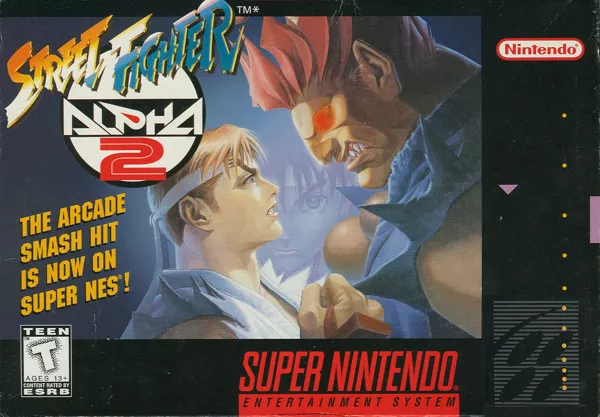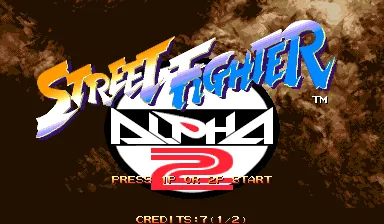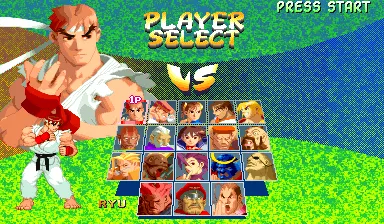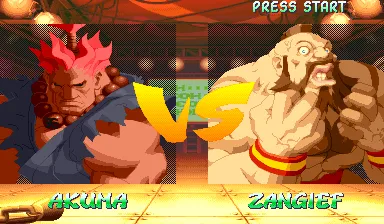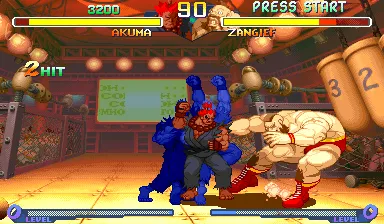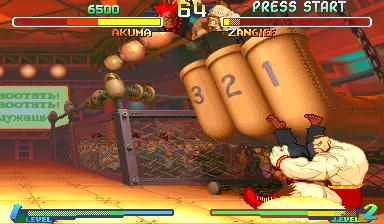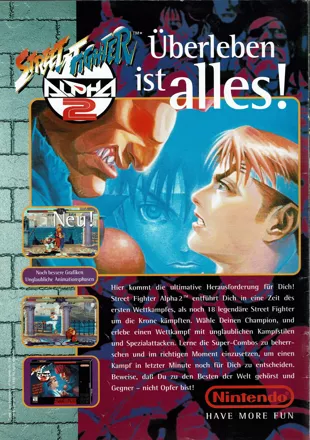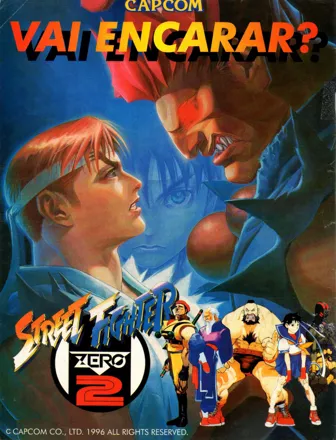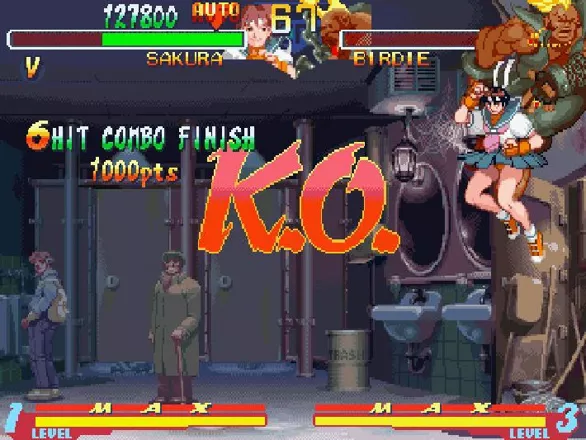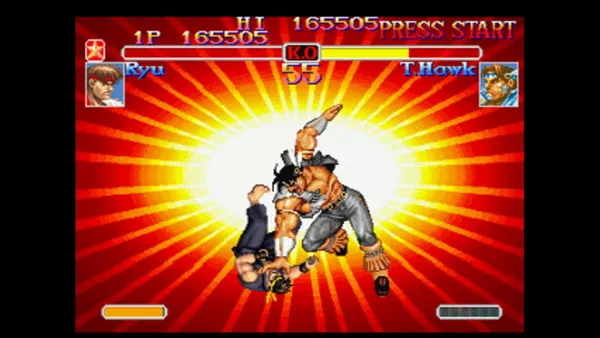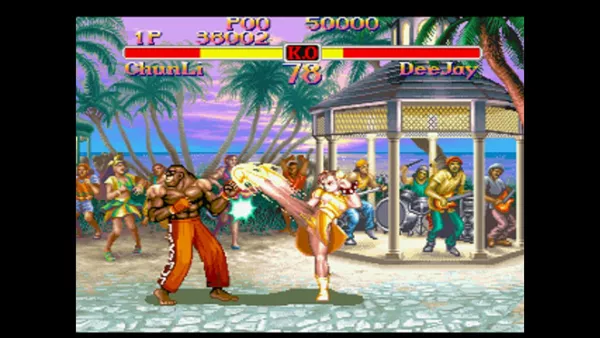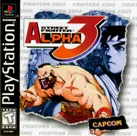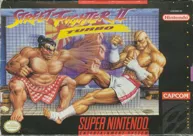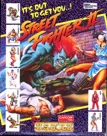Street Fighter Alpha 2
Description official descriptions
Another Street Fighter sequel (this time for Street Fighter Alpha) adds even more to the classic fighting series.
New characters in this version include Gen (a wise kung-fu master), Rolento (who you may remember from another Capcom classic, Final Fight) and Sakura, a young school girl who follows her hero Ryu so close, she has the same type of moves. Dhalsim and Zangief also return to the fight with some news moves.
The other major difference is the loss of chain-combos and the gain of a custom combo system. Once you reach the required level (which is 1 at the least) you can execute a custom combo by combining any of the buttons (which there are 6 in total) or any of the special attacks (fireballs, etc.)
Spellings
- ストリートファイター ゼロ2 - Japanese spelling
Groups +
Screenshots
Promos
Videos
Add Trailer or Gameplay Video +1 point
See any errors or missing info for this game?
You can submit a correction, contribute trivia, add to a game group, add a related site or alternate title.
Credits (SNES version)
107 People (85 developers, 22 thanks) · View all
| Planner |
|
| Programmer |
|
| Scroll Design |
|
| [ full credits ] | |
Reviews
Critics
Average score: 82% (based on 39 ratings)
Players
Average score: 4.0 out of 5 (based on 104 ratings with 4 reviews)
The Good
Street Fighter Alpha 2 is really the full version of the original SFA, with all the intended characters, backgrounds and features Capcom had originally devised for the Alpha series, as such the easiest way to think about it is as a SFA on steroids.
For starters you now have 18 characters to choose from (setting a new record for SF) including every character found on the original Alpha as well as even more reworked SF1 characters like Gen, Final Fight veteran Rolento, returning SF2 favorites Zangief & Dhalsim, and original characters as Sakura that finally allow gamers to play as a sailor suit-wearing, schoolgirl version of Ryu... Yay!! Sakura is the first "Kawaii" character to find it's way in the SF universe and as such it's a notable (or embarrasing depending on who you talk to) event in SF history...well guess if the KOF series can have 50 nausea-inducing cutie-cutie sugar-coated characters then we can allow Capcom to sneak one in.
Anyway, this time each character has a proper background stage each lovingly detailed and populated as opposed to SFA1's lame deserted stages. There are actually more stages than fighters as the game even comes with a group of special ones used on certain vs and end-game battles, such as the grass field for the Sagat/Ryu end battle that mimicks the opening fight on the Street Fighter animated movie.
Gameplay-wise the game is pretty much the same as the prequel, which is good. The action is still the standard-setting arcade gameplay Capcom is known for, with fast yet rewarding gameplay, balanced characters and responsive controls, while the game works in the same way as the original, as more personal tournaments for each character with middle bosses and end game battles that have to do with their particular stories. Capcom changed a couple of things though, first of all the chain combo system is gone, which is a good change if you ask me as the system was more fit for over the top fighting games like X-Men and Marvel Super Heroes rather than SF. Second, there's a new "Custom Super" that works as a generic super-status upgrade where your character turns into a super-fast version of your former self that can cancel most of his regular moves into really amazing combos while his power bar depletes. Not a really hot addition if you ask me as you don't gain hit priority or damage bonus, but some people seem to like it... The rest of the additions are either new moves and supers for the returning characters as well as small modifications such as both high and low alpha counters that increase the gameplay depth considerably.
Finally, it's worth noting that the PSX manages to port the arcade hit pretty accurately by keeping the load times to a minimum and only losing some frames and misc. features in the process. Sure, it may not be perfect but it earns points for delivering the arcade experience more or less intact.
The Bad
The music is absolutely AWFUL! The Alpha series had brought the game into the next millenium sound-wise with cleaner digitized samples and great SFX, but the music for this particular one is among the worst composed for a fighting game ever. They are a collection of grating bossa-nova like tunes that will have you popping a cd in the nearest boombox in no time. The only barely acceptable tunes are Akuma's and Ryu's but they are still pretty lacking.
Finally, the port itself misses some features from the arcade version, such as a couple of secret characters, color schemes, frames, etc. The game is still the same, but the Saturn version is far superior (as usual). There's also the bare-bones release Capcom did in those days to consider, which still seems to use the same template as the SNES SF2 port...
The Bottom Line
A new and well-earned success for Capcom that delivers a solid port of a great fighting game with superb action and gameplay for any action gamer to enjoy. You can't go wrong with SFA2. Keep in mind though, that the best release for the game is the Saturn one, just in case you want to get the absolutely best Alpha 2 experience.
PlayStation · by Zovni (10504) · 2004
A Windows 95 gem forgotten by history.
The Good
It's on Windows 95 and runs swell on a Pentium II at 350 MHz with 64 MB of RAM and an ATi Rage with 4 MB of vRAM. It takes about 400 MB of HD space or so, and the music is all in .WAV files, so it can be converted to .MP3 or *.AAC for use on your favorite digital music player.
The graphics are 320x200 at VGA, but that's okay, because Capcom stuck a lot of effort in those graphics, and the game looks great!
Sounds great, too, because QSound is applied to all of the *.WAV music and sound files, and using a Microsoft SideWinder or Capcom's own ProPad 6 is a dream.
There's almost no access time from the hard drive in between matches, and everything's here that's on the Saturn version. Video is used for the intro and a few other tricky points to save the limitations of the majority of Windows 95 PCs at the time (you know, the one your lawyer brother-in-law in his mid-30s refuses to upgrade or give up on, and it doesn't even have USB) so that's forgiven.
The Bad
Still, 320x200? Why? The SNES I can undestand, that's in it's hi-res mode, but that's the low-res mode for Windows 95 by 1998, the year of its release. Windows 95 on my Pentium II system was at least 640x480 in thousands of colors (24-bit mode, 32-bit mode ran my resources dry). When Acclaim and Capcom did X-Men: COTA on DOS, they did right by allowing a 65,000 color mode if your system RAM was 16 MB or more, and that was nice. This is four years later (a long time in a game's life) and there's not even that option. It's not really bothersome unless you've become used to the Saturn and PlayStation's 320x200 modes in 65,000, which comes off sharp. I think Capcom could've just upped it to 32,000 colors at the 640x480 res mode, and it would've looked spectacular.
Also, since most PCs don't have an extra game port, I think Capcom should've included a Y-splitter for two joypad support. But what was I expecting for $19.99? Yes, that was its actual retail price with a little manifesto from Capcom stating how they wanted to put all of their games on PC from that point on (yeah, sure).
The Bottom Line
After being burned by the Saturn in 1995 and the Nintendo 64 in 1996, 1997 to 2000 was the time I turned to Windows 95/98 for my gaming fixes. If more games like this version of Alpha 2 were pumped out by the console companies, I'd be in Utopia. But Final Fantasy 7 sealed our fate on that (not Capcom, these games were decent). If you see it used, I say buy it, but it conflicts with Windows ME, 2000, XP and most likely won't run on Vista if it's on a 64-bit CPU.
Windows · by Fake Spam (85) · 2006
Arcade goodness, as well as the SNES can do it.
The Good
Graphically, sound-wise, musically, control, everything's here that's on the 32-bit versions. All is good and is fun to play. Even the intro is completely here.
The Bad
Slower than the other versions, though can get used to it. What really gets me is this is a cart, and yet there's access time. On a cart? What? I thought the principle of the cart was to extend the basic elements of the game as simulated RAM, and the RAM would just keep things like the high score and other user-input data. But no, there's access right before every round starts, and that's annoying.
The Bottom Line
Still avoiding the optical disc revolution, then buy this game by all means. If you can get used to the access time, you can enjoy one of the best fighting games on the SNES.
SNES · by Fake Spam (85) · 2006
Trivia
Decompression Chip
Together with Star Ocean and Tengai Makyō Zero, this was the only game for the SNES to include the S-DD1 chip. This chip allowed sprite data to be decompressed in real time, and is only one of the various chips that allowed SNES games to stay ahead in the 16-bit console market for a while. It was also one of the latest obstacles that hindered SNES emulation: before the chip was completely emulated, "graphic packs" with the uncompressed graphics were necessary in order to play the game.
PlayStation Omissions
Missing from the Playstation version of the game are the characters Evil Ryu, Classic Dhalsim and Classic Zangief. Plus the number of color palettes available for each character has been reduced to 2.
References
There are several in-jokes and messages hidden in the game, for instance on Ken's stage you can find lots of Capcom characters, among them you may find a Strider Hiryu holding a Teddy Bear. This was sort of a "get well soon" message left for a fellow Capcom member who worked under tremendous stress on a Neo-geo pocket version of Strider, and when that version was ultimately canned, had a nervous breakdown, and had to be hospitalized.
SNES Version
Despite an admirable effort, Capcom's port of Alpha 2 to the SNES took some serious sacrifices, namely in graphics (characters aren't as detailed, and frames were removed from animations) and sound. There was also a small but annoying load time (?!) at the start of each round, and even then the game was slow, even when the speed was cranked to its highest setting. Also, in another move in Nintendo's infamous censoring activities, the character 'Sodom' was renamed 'Katana', since 'Sodom' was too close the word 'Sodomy' (taken from an actual city in the Bible called Sodom, where people committed immoral sex acts). Even though Sodom's name (the character) is pronounced 'So-dum', not 'Saw-dum' (the place in the Bible).
Awards
- Electronic Gaming Monthly
- December 1996 (Issue 89) - Game of the Month (Saturn version) (shared with Tomb Raider)
- March 1997 (Issue 92) - Saturn Game of the Year runner-up + Arcade Game of the Year + Fighting Game of the Year runner-up (Saturn version) + Saturn Game of the Year runner-up (Readers' Choice) + Arcade Game of the Year (Readers' Choice)
- November 1997 (Issue 100) - ranked #36 (Best 100 Games of All Time) (Saturn version)
Analytics
Identifiers +
Contribute
Are you familiar with this game? Help document and preserve this entry in video game history! If your contribution is approved, you will earn points and be credited as a contributor.
Contributors to this Entry
Game added by Kartanym.
Wii added by Charly2.0. New Nintendo 3DS, PS Vita added by GTramp. Wii U added by Michael Cassidy. Arcade added by 666gonzo666. PSP, PlayStation 3 added by Foxhack. Windows added by Satoshi Kunsai.
Additional contributors: Matthew Bailey, Zovni, Alaka, ケヴィン, piltdown_man, Plok.
Game added April 5th, 2001. Last modified January 8th, 2024.
